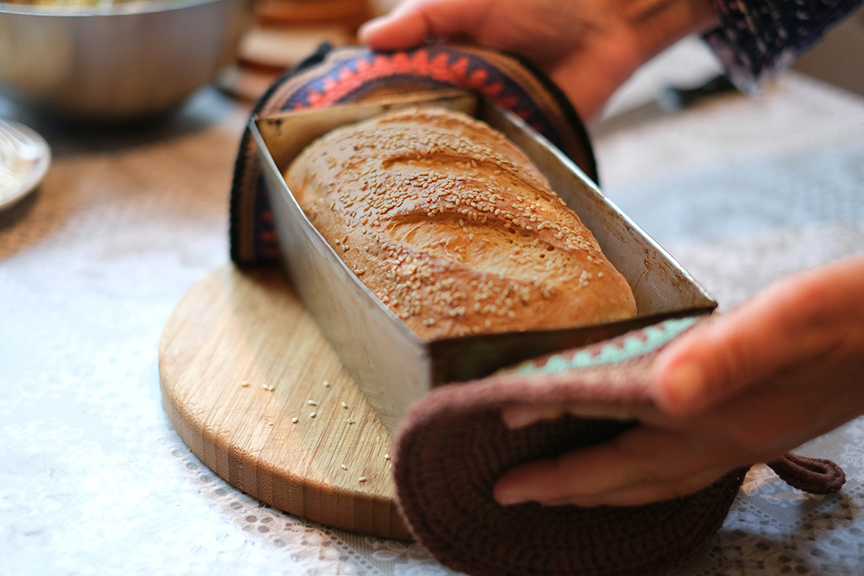Manage my booking
THE TRAVEL BLOG OF BALTIC TOURS

Bread: A Symbolic Tradition in Lithuanian Culture
Bread holds a special place in Lithuanian culture, not just as a staple food but as one of the main symbols of the nation, occupying the most honorable place in the hearts of Lithuanian people. Baltic Tours invites you to delve into the significance of Lithuanian bread and its cultural importance.


 Since ancient times, on February 5th, Lithuanian culture has revered the goddess of fire, Gabija, and everyday food—bread—that protected against fire and disease. In the modern world, bread is less frequently baked at home, with a wide selection available in supermarkets and traditional bakeries. To delve deeper into the traditions of bread and its cooking, consider visiting the Bread and Fire Festival in Prienai!
Let’s travel with bread crumbs through Lithuania! Check our deals and book your holidays now!
Since ancient times, on February 5th, Lithuanian culture has revered the goddess of fire, Gabija, and everyday food—bread—that protected against fire and disease. In the modern world, bread is less frequently baked at home, with a wide selection available in supermarkets and traditional bakeries. To delve deeper into the traditions of bread and its cooking, consider visiting the Bread and Fire Festival in Prienai!
Let’s travel with bread crumbs through Lithuania! Check our deals and book your holidays now!
Origins of Bread
The origins of bread date back to early Neolithic times when millstones were invented. Hard bread was baked from a mixture of grain and water. With the advent of agriculture and grain cultivation, unleavened bread was created and baked on prized flat stones. In Lithuania, written sources mention the use of bread since the first century after Christ and its baking in the 2nd-3rd centuries. Until the 20th century, bread was the main Lithuanian meal, baked in two ways: sourdough and unleavened.
What Bread Symbolizes
According to Lithuanian folk wisdom, bread symbolizes human strength, intelligence, self-control, loyalty, kindness, humility, and, most importantly, it represents the essential daily sustenance. Therefore, in Lithuania, bread is a symbol of life, attesting to well-being, happiness, and fertility with its miraculous powers.The Benefits of Bread
Bread is a great source of energy, rich in various vitamins essential for the human body, especially potassium, sodium, chlorine, and sodium. Additionally, bread contains fibrous substances, beneficial for intestinal health. In Lithuanian folk medicine, bread is widely used to prevent serious diseases, heal difficult-to-treat abscessing wounds, and soothe frightened children.Bread Beliefs
Various prophetic signs and superstitions are associated with bread in Lithuania. It was believed that a loaf of bread, or even a bread crumb, was connected to human life. For this reason, throwing away bread or leaving an uneaten piece on the table was considered taboo, as another person might consume your share of life. Similarly, it was customary to take the last slice only if it was not offered to you.
Bread Customs
Lithuanian bread has long been accompanied by various customs, such as carrying a piece of bread sanctified by the church in one's pocket or making crosses and circles on the first bread loaf, symbolizing fire and the sun. A prevalent custom in Lithuania today involves people reverently lifting a piece of bread that falls to the ground, kissing it, and consuming it. The belief is that apologizing to the fallen bread prevents it from harboring anger and leaving the house.Types of Bread in Lithuania
Bread in Lithuania is typically made from a mixture of rye, wheat, and triticale flour, combined, shaped, leavened with yeast and lactic acid bacteria. The most renowned national heritage of Lithuania is dark rye bread, traditionally made from kneading whole grain rye flour, water, and seasoned with salt or occasionally cumin or coriander seeds. The bread is baked in a 350-degree heated oven, forming a crust that aids in ripening. However, today, only a few places in Lithuania still bake this type of bread. Since ancient times, on February 5th, Lithuanian culture has revered the goddess of fire, Gabija, and everyday food—bread—that protected against fire and disease. In the modern world, bread is less frequently baked at home, with a wide selection available in supermarkets and traditional bakeries. To delve deeper into the traditions of bread and its cooking, consider visiting the Bread and Fire Festival in Prienai!
Let’s travel with bread crumbs through Lithuania! Check our deals and book your holidays now!
Since ancient times, on February 5th, Lithuanian culture has revered the goddess of fire, Gabija, and everyday food—bread—that protected against fire and disease. In the modern world, bread is less frequently baked at home, with a wide selection available in supermarkets and traditional bakeries. To delve deeper into the traditions of bread and its cooking, consider visiting the Bread and Fire Festival in Prienai!
Let’s travel with bread crumbs through Lithuania! Check our deals and book your holidays now!


Professionally educated and highly experienced in tourism management, Rasa is passionate about encouraging guests to explore the Northeastern region of Europe in the most attractive way. She has been working in the tourism industry since 2000, assisting customers from 64 countries, and she loves doing it!
ASK A QUESTION